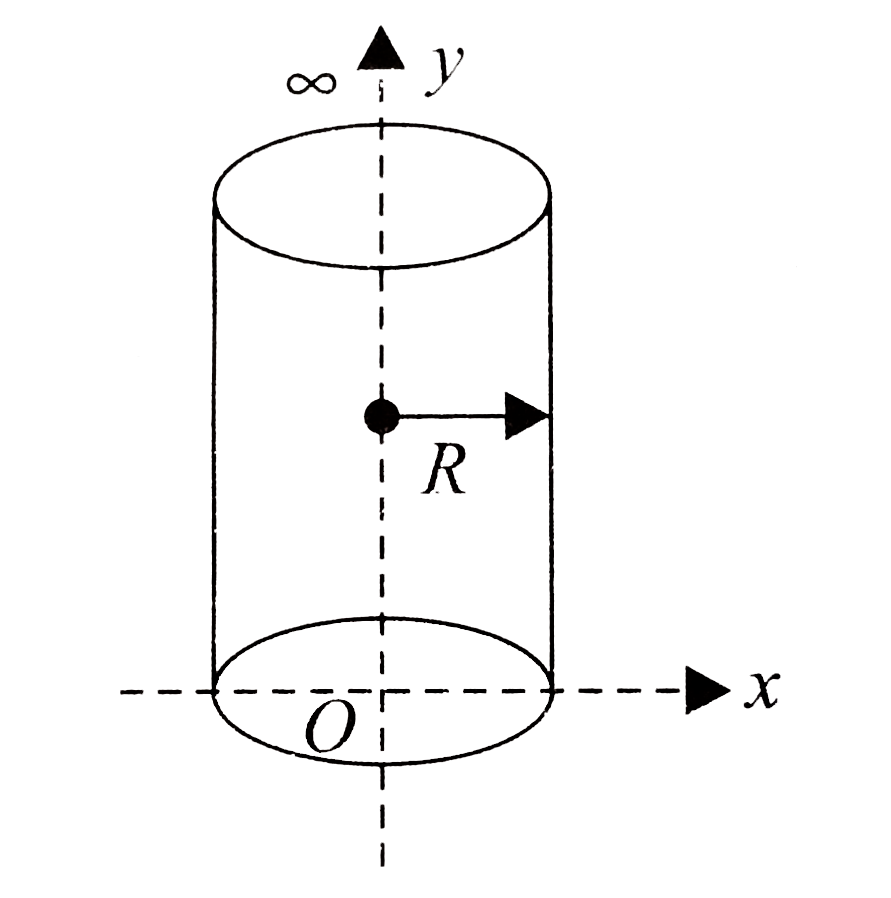Current density in a cylindrical wire of radius R is given as J=⎧⎪⎨⎪⎩J0(xR−1) for 0≤x<R2J0xR for R2≤x≤R.
If the current flowing in the wire is k12πJ0R2, find the value of k.
The correct Answer is:5
To find the value of k in the given problem, we will follow these steps:
Step 1: Understand the Current Density Function
The current density J is given as:
J=⎧⎪⎨⎪⎩J0(xR−1)for 0≤x<R2J0(xR)for R2≤x≤R
Step 2: Calculate the Current from Current Density
The total current I flowing through the wire can be calculated by integrating the current density over the cross-sectional area of the wire. The current I can be expressed as:
I=∫R0JdA
where dA=2πxdx is the differential area element.
Step 3: Split the Integral
We will split the integral into two parts based on the piecewise definition of J:
I=∫R/20J0(xR−1)(2πx)dx+∫RR/2J0(xR)(2πx)dx
Step 4: Calculate Each Integral
1. First Integral:
I1=∫R/20J0(xR−1)(2πx)dx
This simplifies to:
I1=2πJ0∫R/20(x2R−x)dx
Evaluating this integral:
I1=2πJ0(x33R−x22)R/20=2πJ0((R/2)33R−(R/2)22)
=2πJ0(R224−R28)=2πJ0(R224−3R224)=2πJ0(−2R224)=−πJ0R212
2. Second Integral:
I2=∫RR/2J0(xR)(2πx)dx
This simplifies to:
I2=2πJ0∫RR/2x2Rdx
Evaluating this integral:
I2=2πJ0(x33R)RR/2=2πJ0(R33R−(R/2)33R)
=2πJ0(R23−R224)=2πJ0(8R224−R224)=2πJ0(7R224)=14πJ0R224=7πJ0R212
Step 5: Combine the Results
Now, combine I1 and I2:
I=I1+I2=−πJ0R212+7πJ0R212=6πJ0R212=πJ0R22
Step 6: Set Equal to Given Current
We are given that:
I=k12πJ0R2
Setting the two expressions for current equal gives:
πJ0R22=k12πJ0R2
Dividing both sides by πJ0R2 (assuming J0≠0 and R≠0):
12=k12
Step 7: Solve for k
Multiplying both sides by 12:
k=6
Final Answer
Thus, the value of k is 6.
The current density J is given as:
J=⎧⎪⎨⎪⎩J0(xR−1)for 0≤x<R2J0(xR)for R2≤x≤R
The total current I flowing through the wire can be calculated by integrating the current density over the cross-sectional area of the wire. The current I can be expressed as:
I=∫R0JdA
where dA=2πxdx is the differential area element.
We will split the integral into two parts based on the piecewise definition of J:
I=∫R/20J0(xR−1)(2πx)dx+∫RR/2J0(xR)(2πx)dx
1. First Integral:
I1=∫R/20J0(xR−1)(2πx)dx
This simplifies to:
I1=2πJ0∫R/20(x2R−x)dx
Evaluating this integral:
I1=2πJ0(x33R−x22)R/20=2πJ0((R/2)33R−(R/2)22)
=2πJ0(R224−R28)=2πJ0(R224−3R224)=2πJ0(−2R224)=−πJ0R212
I2=∫RR/2J0(xR)(2πx)dx
This simplifies to:
I2=2πJ0∫RR/2x2Rdx
Evaluating this integral:
I2=2πJ0(x33R)RR/2=2πJ0(R33R−(R/2)33R)
=2πJ0(R23−R224)=2πJ0(8R224−R224)=2πJ0(7R224)=14πJ0R224=7πJ0R212
Now, combine I1 and I2:
I=I1+I2=−πJ0R212+7πJ0R212=6πJ0R212=πJ0R22
We are given that:
I=k12πJ0R2
Setting the two expressions for current equal gives:
πJ0R22=k12πJ0R2
Dividing both sides by πJ0R2 (assuming J0≠0 and R≠0):
12=k12
Multiplying both sides by 12:
k=6
Thus, the value of k is 6.
Topper's Solved these Questions
- BOOK - AAKASH SERIESCHAPTER - CURRENT ELECTRICITYEXERCISE - ADDITIONAL PRACTICE EXERCISE (LEVEL -II PRACTICE SHEET (ADVANCED) (Straight Objective Type Questions))5videos
CURRENT ELECTRICITY
- BOOK - AAKASH SERIESCHAPTER - CURRENT ELECTRICITYEXERCISE - ADDITIONAL PRACTICE EXERCISE (LEVEL -II PRACTICE SHEET (ADVANCED) (More than One correct answer Type Questions))5videos
CURRENT ELECTRICITY
- BOOK - AAKASH SERIESCHAPTER - CURRENT ELECTRICITYEXERCISE - ADDITIONAL PRACTICE EXERCISE (LEVEL -II LECTURE SHEET (ADVANCED) (Matrix Matching Type Questions))2videos
CURRENT ELECTRICITY
- BOOK - AAKASH SERIESCHAPTER - CURRENT ELECTRICITYEXERCISE - PROBLEMS (LEVEL-II)27videos
CURRENT ELECTRICITY
- BOOK - AAKASH SERIESCHAPTER - DUAL NATURE OF RADIATION AND MATTEREXERCISE - PRACTICE EXERCISEX42videos
DUAL NATURE OF RADIATION AND MATTER
Similar Questions
The current density is a solid cylindrical wire a radius R, as a function of radial distance r is given by J(r)=J0(1−rR) . The total current in the radial regon r = 0 to r=R4 will be :
View SolutionThe current density across a cylindrical conductor of radius R varies in magnitude according to the equation J=J0(1−rR) where r is the distance from the central axis. Thus, the current density is a maximum J0 at that axis (r = 0) and decreases linearly to zero at the surface (r = R). Calculate the current in terms of J0 and the conductor 's cross - sectional area A=πR2.
View SolutionA cylindrical wire of radius R has current density varying with distance r form its axis as J(x)=J0(1−r2R2) . The total current through the wire is
View SolutionThe current density in a wire of radius a varies with radial distance r as J=J0r2a, where J0 is a constant. Choose the incorrect statement.
View SolutionA solid ball of radius R has a charge density ρ given by ρ=ρ0(1−rR)for0≤r≤R The electric field outside the ball is :
View SolutionSuppose f:[−2,2]→R is defined by f(x)={−1 for −2≤x≤0x−1 for 0≤x≤2 , then {x∈[−2,2]:x≤0andf(|x|)=x}=
View SolutionAn infinite cylindrical wire of radius R and having current density varying with its radius r as, J=J0[1−(r/R)]. Then answer the following questions.

Graph between the magnetic field and radius isView SolutionAn infinitely long cylinderical wire of radius R is carrying a current with current density j=αr3 (where α is constant and r is the distance from the axis of the wire). If the magnetic fixed at r=R2 is B1 and at r=2R is B2 then the ratio B2B1 is
View SolutionThe current density ¯¯¯J inside a long, solid cylindrical wire of radius a=12mm is in the direction of the central axis, and its magnitude varies linearly with radial distance r from the axis according to J=J0ra, where J0=1054πA/m2. Find the magnitude of the magnetic field at r=a2 in μT
View SolutionThe current density ¯¯¯J inside a long, solid cylindrical wire of radius a=12mm is in the direction of the central axis, and its magnitude varies linearly with radial distance r from the axis according to J=J0ra, where J0=1054πA/m2. Find the magnitude of the magnetic field at r=a2 in μT
View Solution

